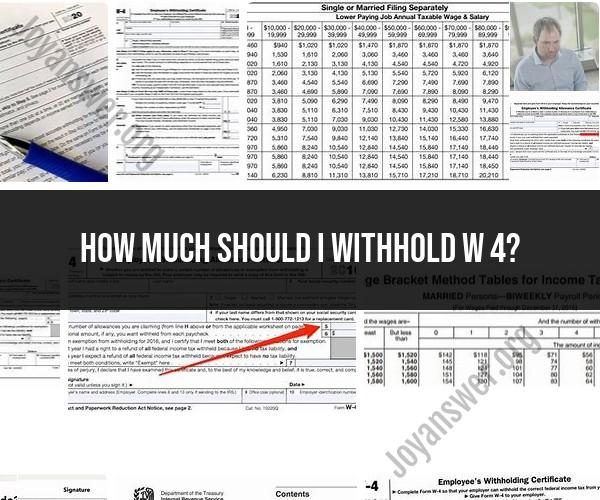How much should I withhold W 4?
Determining how much you should withhold on your W-4 form depends on your individual financial and tax circumstances. The goal is to have the correct amount of federal income tax withheld from your paychecks to meet your tax liability without either significantly overpaying or underpaying. Here are some factors to consider when deciding how much to withhold on your W-4:
Filing Status: Your filing status (e.g., Single, Married Filing Jointly, Head of Household) affects your tax brackets and standard deduction. Ensure that your W-4 reflects your correct filing status.
Income Sources: If you have multiple sources of income, like a part-time job or freelance work, you'll need to account for all your income when determining withholding. Use the IRS's Tax Withholding Estimator for accuracy.
Dependents: Claiming allowances for dependents reduces your taxable income and withholding. Consider the number of dependents you have and adjust your W-4 accordingly.
Tax Credits: If you expect to qualify for tax credits like the Child Tax Credit or Earned Income Tax Credit, you may adjust your withholding accordingly to account for these credits.
Deductions and Itemizing: If you anticipate itemizing deductions on your tax return (e.g., mortgage interest, state and local taxes), you might need to withhold less since these deductions lower your taxable income. Use the IRS's Schedule A to itemize deductions.
Additional Withholding: If you have significant non-wage income (e.g., interest, dividends, capital gains) or self-employment income, you may need to request additional withholding to cover these tax liabilities.
Tax Liability: Consider your total estimated tax liability for the year, including any potential changes due to life events (e.g., marriage, birth of a child). Use the IRS's Tax Withholding Estimator to get a more accurate estimate.
Desired Refund or Owing Taxes: Some individuals prefer to receive a tax refund, while others prefer to owe a small amount when filing their tax return. Adjust your W-4 based on your preference. If you want a larger refund, you may choose to withhold more.
Review Periodically: Tax situations can change throughout the year. It's a good practice to review and adjust your W-4 annually or whenever significant life changes occur (e.g., marriage, divorce, buying a home).
IRS Withholding Calculator: The IRS provides a Tax Withholding Estimator on its website to help you calculate the appropriate withholding based on your specific circumstances.
Ultimately, the right amount to withhold on your W-4 depends on your financial goals, tax situation, and personal preferences. It's essential to strike a balance to avoid overpaying or underpaying your taxes. If you're unsure about the appropriate withholding, consider consulting with a tax professional for personalized guidance.
Finding the Right Balance: How Much Should You Withhold on Your W-4?
The amount of tax withheld from your paycheck each pay period is determined by your W-4 form. This form is used by your employer to calculate the amount of federal income tax to withhold from your pay.
There are a few factors to consider when deciding how much tax to withhold on your W-4 form, including:
- Your income: The more money you make, the more tax you will owe. If you expect to have a high income, you may want to have more tax withheld from your paycheck to avoid a large tax bill at the end of the year.
- Your tax bracket: Your tax bracket determines the rate at which you pay taxes. If you are in a higher tax bracket, you will pay more taxes on your income. You may want to have more tax withheld from your paycheck if you are in a higher tax bracket.
- Your deductions: Deductions are expenses that you can subtract from your income to reduce your taxable income. If you have a lot of deductions, you may want to have less tax withheld from your paycheck.
- Your other financial obligations: If you have other financial obligations, such as mortgage payments or student loan payments, you may want to have more tax withheld from your paycheck to avoid having to make large payments at the end of the year.
W-4 Withholding: Determining the Appropriate Amount for Your Paycheck
To determine the appropriate amount of tax to withhold from your paycheck, you can use the IRS's W-4 Withholding Estimator. This estimator will help you determine how much tax to withhold based on your income, tax bracket, deductions, and other financial obligations.
Once you have determined the appropriate amount of tax to withhold, you can update your W-4 form with your employer. You can update your W-4 form at any time, so you can adjust your withholding as needed throughout the year.
Tax Planning: Understanding W-4 Withholding and Your Pay
Understanding W-4 withholding and how it affects your pay is an important part of tax planning. By carefully considering your income, tax bracket, deductions, and other financial obligations, you can determine the appropriate amount of tax to withhold from your paycheck. This can help you avoid a large tax bill at the end of the year or having to make large payments to cover your tax liability.
Here are some additional tips for tax planning:
- Keep good records of your income and expenses. This will help you to accurately estimate your tax liability for the current year and to prepare your tax return at the end of the year.
- Review your W-4 form annually. Your financial situation may change throughout the year, so it is important to review your W-4 form annually to make sure that your withholding is accurate.
- Consider making estimated tax payments. If you expect to owe more than $1,000 in taxes at the end of the year, you may want to consider making estimated tax payments throughout the year. This can help you to avoid a large tax bill at the end of the year.
- Consult with a tax professional. If you have any questions about tax planning or W-4 withholding, you can consult with a tax professional for assistance.













